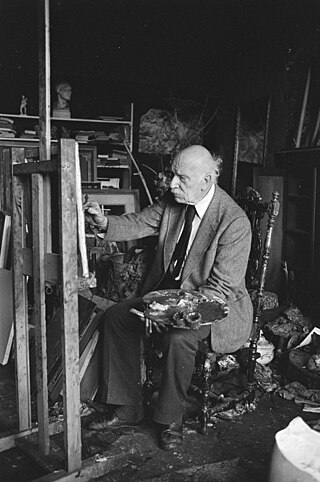De Grootste Nederlander was a public poll held in 2004 by the broadcasting company KRO of the Publieke Omroep. The series has the BBC's 100 Greatest Britons TV format. During the series, it included individual programmes on the top ten, with viewers having further opportunities to vote after each programme.

The Hague School is a group of artists who lived and worked in The Hague between 1860 and 1890. Their work was heavily influenced by the realist painters of the French Barbizon school. The painters of the Hague school generally made use of relatively somber colors, which is why the Hague School is sometimes called the Gray School.

Go Ahead Eagles are a Dutch professional football club from the city of Deventer. They play in the Eredivisie, the top tier of Dutch football, having achieved promotion from the second tier Eerste Divisie in the 2020-21 season. The club's home stadium since 1920 is De Adelaarshorst. The club have won the national championship on four occasions, in 1917, 1922, 1930 and 1933.

The Netherlands competed at the 1948 Summer Olympics in London, England. 149 competitors, 115 men and 34 women, took part in 74 events in 18 sports.

The Royal Academy of Art is an art and design academy in The Hague. Succeeding the Haagsche Teeken-Academie, the academy was founded on 29 September 1682, making it the oldest in the Netherlands and one of the oldest in the world. The academy has been the training ground for a number of significant artists of the Hague School. It was part of the art movement of Dutch Impressionism and in the immediate vicinity of the II. Golden Age of Dutch painting. In the 19th century, however, training was still strongly oriented towards the classic curriculum. At the end of the 19th century, the academy had opened to Modernism, too.
HVV (Haagse Voetbal Vereniging: Dutch for is an amateur football club in The Hague, Netherlands. It was founded in 1883 as an extension of HCC, Hague Cricket Club. In 1978, on the occasion of the club's centenary, Queen Juliana granted the club royal patronage, with prefix Koninklijke, because of its pioneering role in sport, including in the formation of the Royal Dutch Football Association in 1889. Since then it has been called Koninklijke Haagse Cricket & Voetbal Vereniging, abbreviated KHC&VV. The club's grounds since 1898 have been at the 1,200-capacity "De Diepput", on the border between Benoordenhout and Wassenaar. It now also plays tennis, squash and judo and has around 1750 members.
Hermanus (Herman) Berserik was a Dutch painter and print maker. He was a member of the Pulchri Studio in The Hague. He studied art at that city's Royal Academy of Art, where his teachers included Willem Schrofer, Willem Jacob Rozendaal, and Rein Draijer.

Kunst zij ons doel, or KZOD, is the name of an artists club in the Waag, Haarlem.

Henri Frédéric Boot, was a Dutch painter and printmaker mostly active in Haarlem.

Kees Verwey was a Dutch painter who was productive well into old age.
Willem Schrofer was a Dutch art teacher and painter. His vision influenced the Nieuwe Haagse School movement.
Frans Coebel van Loo, Heer of Loo, also known as François Coebel was a Dutch politician and Grand Pensionary of Holland.

The Nederlandsche Vereeniging voor Ambachts- en Nijverheidskunst (V.A.N.K.) was founded in 1904. It was founded by Jacob Pieter van den Bosch, Herman Hana, Klaas van Leeuwen, Theo Molkenboer, and Willem Penaat. At the turn of the century the idea of artist-craftsmen was emerging. The existing Dutch societies and clubs for painters and architects did not adequately represent these artisans and they formed V.A.N.K., the first society for designers in the Netherlands.

Onze Kunst van Heden was an exhibition held in the winter of 1939 through 1940 at the Rijksmuseum in Amsterdam. Due to the threat of invasion in the years leading up to World War II, the Netherlands' government stored many items from the Rijksmuseum's permanent collection. The resulting empty gallery space was utilized by contemporary Dutch artists to exhibit and sell their art. It was organized by the director of the Rijksmuseum Frederik Schmidt Degener. The show was open to all artists, with each artist allowed to enter four pieces. 902 artists exhibited 3,200 works of art in 74 rooms and cabinets of the Rijksmuseum.
„De kunstenaar kan in tijden van maatschappelijke benauwenis weinig positiefs doen om rampen af te wenden, maar wel kan hij door mede te helpen nationale uitingen op het eigenaardigst naar voren te brengen het gemeenschapsbesef versterken. Wanneer de belangstelling van het publiek uitgaat naar deze manifestatie, die in zulk een omvang in Holland nog niet gezien is, dan zal menige kunstenaar zich op zijn beurt gesterkt voelen".
"The artist can do little positive in times of social distress to avert disasters, but he can, by helping to bring out national expressions in the most idiosyncratic way, strengthen the sense of community. When the public is interested in this event, which has not yet been seen to such an extent in Holland, many artists will feel strengthened in turn."













